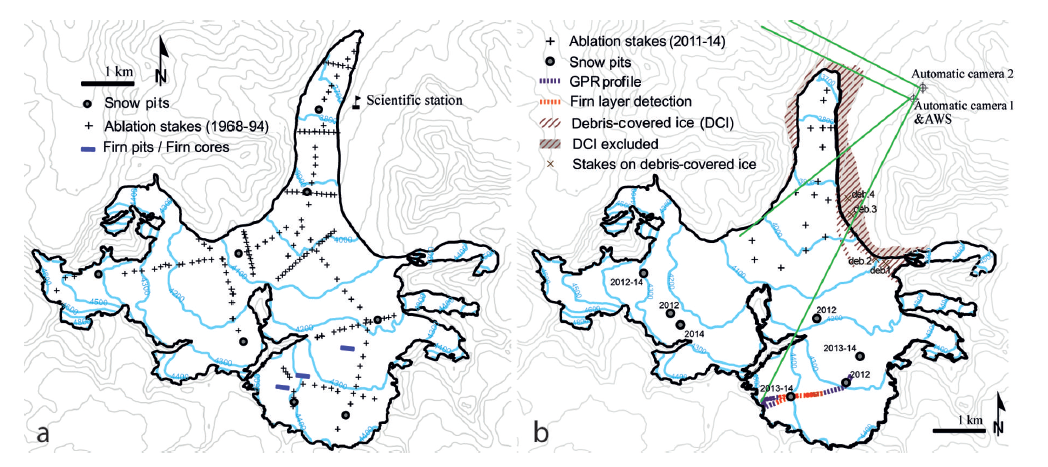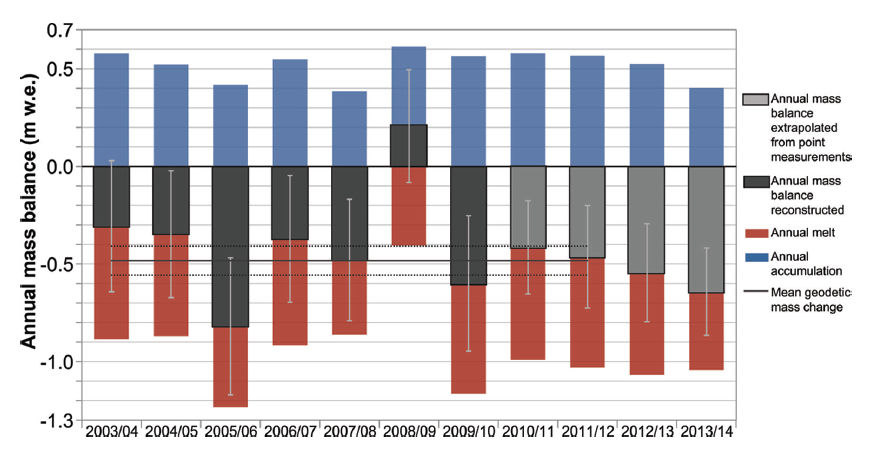Capacity Building and Twinning for Climate Observing Systems (CATCOS)
It is widely recognized that global climate change poses a major threat to sustainable development objectives. In order to build up climate resilience, decisions concerning mitigation and adaptation strategies on climate change must be taken based on high-quality data measured in a sustainable manner. CATCOS allows filling the data gaps in regions where climate-relevant information has been missing or measurements have been ceased. In doing so, the project provides a significant contribution to the Global Climate Observing System (GCOS).
The role of the University of Fribourg in CATCOS:
Central Asia is dependent on glaciers as an essential source of water. In the past, many glaciers have been monitored and a valuable data basis was established. Past mass balance series on Uzbek and Kyrgyz glaciers span more than 20 years but are interrupted in the mid-1990s.
As part of the CATCOS project, systematic glacier observations are re-established at four Kyrgyz glaciers and one Uzbek glacier thanks to a close collaboration between the University of Fribourg and the Central-Asian Institute for Applied Geosciences (CAIAG). All collected data is submitted to the designated International Data Centre, the World Glacier Monitoring Service (WGMS) in Switzerland and freely accessible.
The University of Fribourg instructs local scientists in field operating procedures and teaches them how to apply the measuring equipment considering the specifics of each glacier, including serverel summer schools on “Mass Balance Measurements and Analysis”. Thereby, Kyrgyz participants receive advanced training in both field and office work.
Aims:
1. Re-establishment of historical mass balance monitoring programmes
2. Capacity building and twinning
Study area: Kyrgyzstan: Glacier Abramov (Pamir-Alay), Glacier Golubin (Tien Shan), Glacier Batysh Sook (Tien Shan), Glacier No. 354 (Tien Shan); Uzbekistan: Barkrak Sredniy Glacier (Tien Shan)
-
Project Overview
Figure 2: Measured and re-constructed mass balance for Gl. No.354 (Kronenberg et al., 2016)
Figure 3: Photo from joined field work with local partners at Abramov Glacier (Photo taken by T. Saks).
Figure 4: Photo from the summer school on mass balance measurements and analysis in 2015 on Batysh Sook Glacier (Photo taken by H.Machguth).
-
Publications
- Barandun, M., Huss, M., Sold, L., Farinotti, D., Azisov, E., Salzmann, N., Usubaliev, R., Merkushkin, A., & Hoelzle, M. (2015). Re-analysis of seasonal mass balance at Abramov glacier 1968–2014. Journal of Glaciology, 61(230), 1103-1117.
- Kronenberg, M., Barandun, M., Hoelzle, M., Huss, M., Farinotti, D., Azisov, E., ... & Kääb, A. (2016). Mass-balance econstruction for Glacier No. 354, Tien Shan, from 2003 to 2014. Annals of Glaciology, 57, 71.
- Kenzhebaev, R., Barandun, M., Kronenberg, M., Yaning, C., Usubaliev, R., Hoelzle, M., (2017). Mass balance observations and reconstruction for Batysh Sook Glacier, Tien Shan, from 2004 to 2016: Cold Regions Science and Technology, v. 135, p. 76-89.
- Hoelzle, M., Azisov, E., Barandun, M., Huss, M., Farinotti, D., Gafurov, A., Hagg, W., Kenzehbaev, R., Kronenberg, M., Machguth, H., Merkushkin, A., Moldobekov, B., Petrov, M., Saks, T., Salzmann, N., Schöne, T., Tarasov, Y., Usubaliev, R., Vorogushyn, S., Yakovlev, A., and Zemp, M., 2017, Re-establishing glacier monitoring in Kyrgyzstan and Uzbekistan, Central Asia: Geoscientific Instrumentations, Methods and Data Systems, v. 6, p. 297-418.
- http://www.adjacentgovernment.co.uk/farming-environment-marine-sustainable-news/analysing-glaciers-to-fight-climate-change/25090/
- http://www.internationalinnovation.com/climate-change-monitoring-developing-world/
- http://www.azernews.az/analysis/87483.html
- http://caa-network.org/archives/5088
Duration: 2011-2016
Funded by: CATCOS is funded by the Swiss Agency for Development and Cooperation SDC and is coordinated by the Federal Office of Meteorology and Climatology MeteoSwiss. The project is realized through a close collaboration between Swiss and international partners from Africa, South East Asia, South America and Central Asia. As a global partner, the World Meteorological Organization WMO is instrumental in embedding the activities in the respective regions.
Collaborators: Martin Hoelzle (Prof, UniFR), Bolot Moldobekov (Director, CAIAG), Ryskul Usubaliev (Senior Scientist, CAIAG), Maxim Petrov (Senior Scientist, ), Tomas Saks (Senior Scientist, UniFR), Matthias Huss (Senior Scientist, UniFR, ETHZ), Horst Machguth (Senior Scientist, UniFR, UZH), Nadine Salzmann (Senior Scientist, UnifFR), Abror, Gafurov (Senior Scientist, GFZ), Sergiy Vorogushin (Senior Scientist, GFZ), Aleksandr Merkushkin (Senior Scientist, UNDP, Uzbekistan), Wilfreid Hagg (Senior Scientist, LMU), Michael Zemp (Director, WGMS UZH), Nico Mölg (PhD, WGMS, UZH), Daniel Farinotti (Senior Scientist, WSL), Martina Barandun (PhD student, UniFR), Marlene Kronenberg (PhD student, UniFR, Meteodat), Erlan Azisov (PhD, CAIAG), Ruslan Kenzhebaev (MSc CAIAG), Alyssa Ghirlanda (MSc, UniFR), Florian Denzinger (MSc, UZH, UniFR).
Contact
Dr. Martina Barandun
Geography
Department of Geosciences
University of Fribourg
Chemin du Musée 4
CH–1700 Fribourg
+41 26 300 90 21
Email




